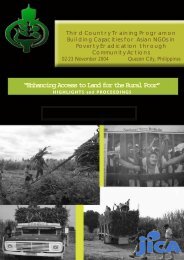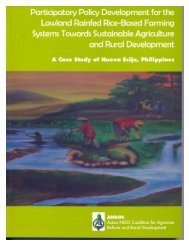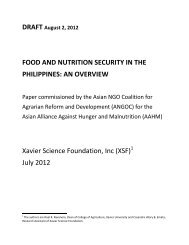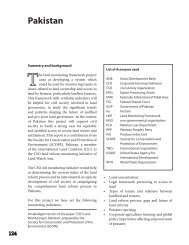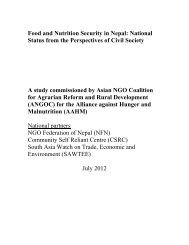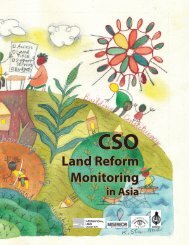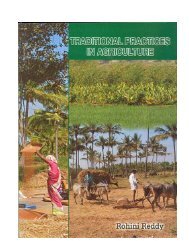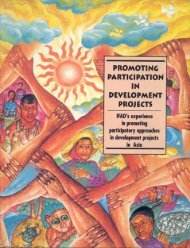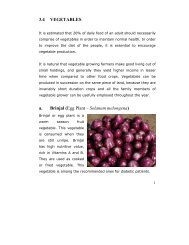Securing the Right to Land FULL - ANGOC
Securing the Right to Land FULL - ANGOC
Securing the Right to Land FULL - ANGOC
Create successful ePaper yourself
Turn your PDF publications into a flip-book with our unique Google optimized e-Paper software.
SECURING THE RIGHT TO LAND116<br />
Abolition of Collective <strong>Right</strong>s<br />
Indigenous and ethnic groups are rapidly being displaced from<br />
<strong>the</strong>ir native land. This is <strong>the</strong> result of state-supported activities<br />
on indigenous peoples’ lands that bring in big revenues, such as<br />
oil exploitation, mining, dam building, logging, monoculture of<br />
cash crops, cattle ranches, and <strong>the</strong> establishment of national<br />
parks, nature reservations and <strong>to</strong>urism.<br />
Legal and Policy Framework for<br />
Access <strong>to</strong> <strong>Land</strong><br />
Laws<br />
<strong>Land</strong> Reform Act of 1964<br />
Fixed a ceiling on <strong>the</strong> size of landholdings;<br />
Sought <strong>to</strong> protect <strong>the</strong> rights of tenants by including <strong>the</strong>ir<br />
names in <strong>the</strong> owner’s land title;<br />
Fixed <strong>the</strong> rent on agricultural land and reduced interest on<br />
rural loans;<br />
Allowed tenants <strong>to</strong> apply for tenancy rights at <strong>the</strong> District<br />
<strong>Land</strong> Reform Office (DLRO) provided that <strong>the</strong>y had tilled <strong>the</strong><br />
land <strong>the</strong> previous year and could present proof of this fact,<br />
such as a grain payment receipt;<br />
Has been amended 6 times, <strong>the</strong> most important being:<br />
Fourth Amendment (1996)<br />
> Provided that <strong>the</strong> land being cultivated by <strong>the</strong> tenant be<br />
divided equally between landlord and tenant, <strong>to</strong> ensure<br />
that tenants would become landowners <strong>the</strong>mselves<br />
> A credit facility would also be made available <strong>to</strong> <strong>the</strong> tenant<br />
who wished <strong>to</strong> buy <strong>the</strong> landlord’s half;<br />
> Sought <strong>to</strong> abolish dual ownership of land.<br />
Fifth Amendment [failed <strong>to</strong> be implemented in 2001]<br />
> Attempted <strong>to</strong> reduce <strong>the</strong> ceiling on <strong>the</strong> size of landholdings.<br />
Problems in implementation:<br />
> Despite <strong>the</strong> law’s intent <strong>to</strong> abolish <strong>the</strong> practice of dual<br />
ownership of land, as much as 13% of landholdings and<br />
Table 2. Tenants and Tenancy, 1961–2001<br />
8.7% of all farmlands remain under this arrangement.<br />
The likelihood that <strong>the</strong> incidence of dual ownership of<br />
land could even be higher than officially reported due <strong>to</strong><br />
landowners witholding information or tenants’ fear of<br />
reprisals .<br />
> Gave landlords unrestricted rights <strong>to</strong> evict tenants who<br />
fail or refuse <strong>to</strong> pay higher rents; thus, tenants had no<br />
secure tenancy rights, and were subject <strong>to</strong> arbitrary<br />
rent increases.<br />
> To get around <strong>the</strong> law, landlords evicted <strong>the</strong> tenants<br />
from <strong>the</strong>ir land. Thus, <strong>the</strong>re has been a marked decline<br />
in <strong>the</strong> number of tenants and <strong>the</strong> area under tenancy<br />
from 1961 <strong>to</strong> 2001 (refer <strong>to</strong> Table 2).<br />
> According <strong>to</strong> <strong>the</strong> Badal Commission for <strong>Land</strong> Reform<br />
(1995), more than 450,000 tenant families were not yet<br />
registered, and that even those that have been registered<br />
have not been able <strong>to</strong> avail of <strong>the</strong>ir rights. In 2000-<br />
2001 a survey conducted by <strong>the</strong> Department of <strong>Land</strong><br />
Reform and Management showed 266,261 registered<br />
tenants in 35 districts that were eligible land claimants<br />
but had not been able <strong>to</strong> avail of <strong>the</strong>ir tenancy rights.<br />
About a million poor households (majority of whom are<br />
Dalits) have been deprived of <strong>the</strong>ir rights <strong>to</strong> land.<br />
> A 1973 study showed that close <strong>to</strong> 10 years after <strong>the</strong><br />
enactment of <strong>the</strong> <strong>Land</strong> Act of 1964, only 32,331 hectares<br />
of land had been acquired out of <strong>the</strong> 50,580 hectares<br />
(owned by 9,136 landlords) that had been identified<br />
for distribution, and of this only 64% had been distributed.<br />
Moreover, 31.2% of farmers were still tenants<br />
(Zaman, 1973). Ano<strong>the</strong>r study found that 9.9% of landlords<br />
owned 60.8% of <strong>the</strong> land after 8 years of implementing<br />
<strong>the</strong> <strong>Land</strong> Act, thus leaving <strong>the</strong> pattern of land<br />
distribution basically unchanged (Regmi, 1976). More<br />
recent studies showed that after 20 <strong>to</strong> 30 years of<br />
implementing <strong>the</strong> <strong>Land</strong> Act, 28% of households were<br />
still unregistered tenants, especially in <strong>the</strong> Terai region<br />
(IDS, 1986 and Khanal, 1994).<br />
Description 1961 1971 1981 1991 2001<br />
Total tenant households 40.4 19.0 9.5 15.9 12.2<br />
Area under tenancy (in mill ha.) 25.5 15.9 6.2 8.5 8.7<br />
Source: Ministry of <strong>Land</strong> Reform and Management (2006)



